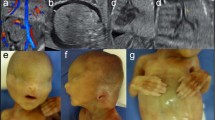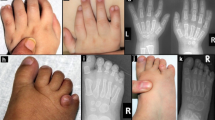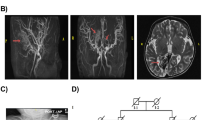Abstract
Mutations in the gene coding for fibrillin on chromosome 15 (FBN1) are known to cause Marfan syndrome (MFS). A related disorder, dominant ectopia lentis (EL), has also been linked genetically to this locus. We now describe ten novel mutations of FBN1 resulting in strikingly different phenotypes. In addition to classic MFS, FBN1 mutations also give rise to EL and a severe neonatal form of MFS. Interestingly, the neonatal MFS mutations are clustered in one particular region of FBN1, possibly providing new insights into genotype–phenotype comparisons.
This is a preview of subscription content, access via your institution
Access options
Subscribe to this journal
Receive 12 print issues and online access
$209.00 per year
only $17.42 per issue
Buy this article
- Purchase on Springer Link
- Instant access to full article PDF
Prices may be subject to local taxes which are calculated during checkout
Similar content being viewed by others
References
Pyeritz, R.E. & McKusick, V.A. The Marfan syndrome: Diagnosis and management. New Engl. J. Med. 300, 772–777 (1979).
Kainulainen, K. Pulkkinen L., Savolainen, A., Kaitila, I. & Peltonen, L. Location on chromosome 15 of the gene defect causing Marfan syndrome. New Engl. J. Med. 323, 935–939 (1990).
Magenis, R.E., Maslen, C.L., Smith, L., Allen, L. & Sakai, L.Y. Localization of the fibrillin (FBN) gene to chromosome 15, band q21.1. Genomics 11, 346–351 (1991).
Dietz, H.C. et al. Marfan syndrome caused by a recurrent de novo missense mutation in the fibrillin gene. Nature 352, 337–339 (1991).
Kainulainen, K. et al. Two mutations in Marfan syndrome resulting in truncated fibrillin polypeptides. Proc. natn. Acad. Sci. U.S.A. 89, 5917–5921 (1992).
Dietz, H.C. et al. Marfan phenotype variability in a family segregating a missense mutation in the epidermal growth factor-like motif of the fibrillin gene. J. clin. Invest. 89, 1674–1680 (1992).
Dietz, H.C., Saraiva, J.M., Pyeritz, R.E., Cutting, G.R. & Francomano, C.A. . Clustering of fibrillin (FBN1) missense mutations in Marfan syndrome patients at cysteine residues in EGF-like domains. Hum. Mut. 1, 366–374 (1992).
Dietz, H.C. et al. The skipping of constitutive exons in vivo induced by nonsense mutations. Science 259, 680–683 (1993).
Hewett, D.R., Lynch, J.R., Smith, R. & Sykes, B.C. A novel fibrillin mutation in the Marfan syndrome which could disrupt calcium binding of the epidermal growth factor-like module. Hum. molec. Genet. 2, 475–477 (1993).
Godfrey, M. et al. Prenatal diagnosis and a donor splice site mutation in fibrillin in a family with Marfan syndrome. Am. J. hum. Genet. 53, 472–480 (1993).
Tsipouras, P. et al. The international Marfan syndrome collaborative study: Genetic linkage of the Marfan syndrome, ectopia lentis, and congenital contractual arachnodactyly to the fibrillin genes on chromosomes 15 and 5. New Engl. J. Med. 326, 905–909 (1992).
Sakai, L.Y., Keene, D.R. & Engvall, E. Fibrillin, a new 350-kD glycoprotein is a component of extracellular microfibrils. J. cell Biol. 103, 2499–2509 (1986).
Maslen, C.L., Corson, G.M., Maddox, B.K., Glanville, R.W. & Sakai, L.Y. Partial sequence of a candidate gene for Marfan syndrome. Nature 352, 334–337 (1991).
Corson, G.M., Chalberg, S.C., Dietz, H.C., Sharbonneau, N.L. & Sakai, L.Y. Fibrillin binds calcium and is coded by cDNAs that reveal a multidomain 33. structure and alternatively spliced exons at the 5′ end. Genomics 17, 476–484 (1993).
Orita, M., Iwahana, H., Kanazava, H., Hayashi, K. & Sekiya, T. Detection of polymorphisms of human DNA by gel electrophoresis as single-strand conformation polymorphisms. Proc. natn. Acad. Sci. U.S.A. 86, 2766–2770 (1989).
Orita, M., Suzuki, Y., Sekiya, T. & Hayashi, K. Rapid and sensitive detection of point mutations and DNA polymorphisms using the polymerase chain reaction. Genomics 5, 874–679 (1989).
Raghunath, M., Superti-Furga, A., Godfrey, M. & Steinmann, B. Decreased extracellular deposition of fibrillin and decorin in neonatal Marfan syndrome fibroblasts. Hum. Genet. 90, 511–515 (1993).
Buntinx, I.M. et al. Neonatal Marfan syndrome with congenital arachnodactyly, flexion contractures, and severe cardiac valve insufficiency. J. med. Genet. 28, 267–273 (1991).
Lee, B., Vitale, E., Superti-Furga, A., Steinmann, B. & Ramirez, F. G to T Transversion at position +5 of a splice donor site causes skipping of the preceding exon in the type III procollagen transcripts of a patient with Ehlers-Danlos syndrome type IV. J. biol. Chem. 266, 5256–5259 (1991).
Lönnqvist, L. et al. A novel mutation of the fibrillin gene causing ectopia lentis. Genomics (in the press).
Schollin, J., Bjarke, B. & Gustavson, K.-H. Probable homozygotic form of the Marfan syndrome in a newborn child. Acta. Pediatr. Scand. 77, 452–456 (1988).
Hayashi, K. PCR-SSCP: a simple and sensitive method for detection of mutations in the genomic DNA. PCR Meth. Applic. 1, 34–38 (1991).
Rees, D.J.G. et al. The role of β-hydroxyaspartate and adjacent carboxylate residues in the first EGF domain of human factor IX. EMBO J. 7, 2053–2061 (1988).
Komoriya, A. et al. Biologically active synthetic fragments of epidermal growth factor: Localization of a major receptor-binding region. Proc. natn. Acad. Sci. U.S.A. 81, 1351–1355 (1984).
Appella, E. et al. The receptor-binding sequence of urokinase. J. biol. Chem. 262, 4437–1440 (1987).
Handford, P.A. et al. Key residues involved in calcium-binding motifs in EGF-like domains. Nature 351, 164–167 (1991).
Winship, P.R. & Dragon, A.C. Identification of haemophilia B patients with mutations in the two calcium binding domains of factor IX: importance of a β-OH Asp 64->sn change. Br. J. Haematol. 77, 102–109 (1991).
Beighton, P. et al. International nosology of heritable disorders of connective tissue, Berlin, 1986. Am. J. med. Genet. 29, 581–594 (1988).
Kanzaki, T. et al. TGF-β1 binding protein: a component of the large latent complex of TGF-β1 with multiple repeat sequences. Cell 61, 1051–1061 (1990).
Byers, P.H. Osteogenesis imperfecta. In: Connective tissue and its heritable disorders: molecular, genetic, and medical aspects (eds Royce, P.M. & Steinmann, B.) 317–350 (Wiley-Liss, New York, 1993).
Beals, R.K. & Hecht, F. Congenital contractural arachnodactyly: A heritable disorder of connective tissue. J. Bone joint Surg. 53, 987–993 (1971).
Milewicz, D.M., Pyeritz, R.E., Crawford, E.S. & Byers, P.H. Marfan syndrome: defective synthesis, secretion, and extracellular matrix formation of fibrillin by cultured dermal fibroblasts. J. clin. Invest. 89, 79–86 (1992).
Mosher, D.F., Sottile, J., Wu, C. & McDonald, J.A. Assembly of extracellular matrix. Cell Biol. 4, 810–818 (1992).
Kelley, M.R., Kidd, S., Deutsch, W.A. & Young, M.W. Mutations altering the structure of epidermal growth factor-like coding sequences at the drosophila Notch locus. Cell 51, 539–548 (1987).
Sanger, F., Nicklen, S. & Coulson, A.R. DNA sequencing with chain-terminating inhibitors. Proc. natn. Acad. Sci. U.S.A. 74, 5463–5467 (1977).
Casanova, J.-L., Pannetier, C., Jaulin, C. & Kourilsky, P. Optimal conditions for directly sequencing double-stranded PCR products with sequenase. Nucl. Acids Res. 18, 4028 (1990).
Syvänen, A.-C., Aalto-Setälä, K., Harju, L., Kontula, K. & Söderlund, H. A primer-guided nucleotide incorporation assay in the genotyping of apolipoprotein E. Genomics 8, 684–692 (1990).
Syvänen, A.-C. et al. Convenient and quantitative determination of the frequency of a mutant allele using solid-phase minisequencing: application to aspartylglucosaminuria in Finland. Genomics 12, 590–595 (1992).
Chou, P.Y. & Fasman, G.D. Prediction of β-turns. Biophys. J. 26, 367–384 (1979).
Author information
Authors and Affiliations
Rights and permissions
About this article
Cite this article
Kainulainen, K., Karttunen, L., Puhakka, L. et al. Mutations in the fibrillin gene responsible for dominant ectopia lentis and neonatal Marfan syndrome. Nat Genet 6, 64–69 (1994). https://doi.org/10.1038/ng0194-64
Received:
Accepted:
Issue Date:
DOI: https://doi.org/10.1038/ng0194-64
This article is cited by
-
Severe phenotypes of B3GAT3-related disorder caused by two heterozygous variants: a case report and literature review
BMC Medical Genomics (2022)
-
Evaluating the sagittal spinal and pelvic parameters in Marfan syndrome patients affected by scoliosis
Spine Deformity (2022)
-
Steered molecular dynamic simulations reveal Marfan syndrome mutations disrupt fibrillin-1 cbEGF domain mechanosensitive calcium binding
Scientific Reports (2020)
-
Enhanced Notch3 signaling contributes to pulmonary emphysema in a Murine Model of Marfan syndrome
Scientific Reports (2020)
-
Transforming growth factor-β in stem cells and tissue homeostasis
Bone Research (2018)



